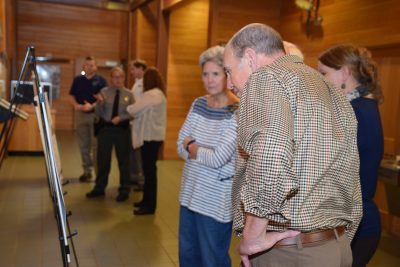SWANSBORO — Now that a long-awaited plan for use of 290 acres of new mainland property at Hammocks Beach State Park is basically complete, Superintendent Sarah Kendrick is excited.

“I’m ready to get started,” Kendrick said. “I don’t think it will happen in the summer – we’re a little busy – but I think that this fall, we’ll be starting on some new trails. We don’t have the money yet, but trails are fairly inexpensive. There are already some trails on the property, and we can expand and improve those, as well as put in some new ones.”
Supporter Spotlight
The trails and other amenities in the plan, she said, will make the park more of a year-round destination. Its primary attraction has long been Bear Island, which is a four-mile-long barrier island served by the park’s ferries in the spring, summer and fall. It’s a popular site, with its unspoiled beach and lifeguards in the summer months, but park visitation dips dramatically when the ferries stop running.
Trails were among the most popular features residents of the area and other park visitors said they wanted to see in the new mainland plan, which was unveiled by Sage Design of Wilmington during a public meeting in the park’s visitors’ center on April 27. A long-discussed large boat-launching facility – maybe as large as the regional facility with two ramps in Emerald Isle – was among the least popular ideas and a source of controversy for more than a year, is not in the plan, although it was in one of two plan “options” unveiled at a similar public meeting in February. And even that plan showed the facility not on the new property, but on the southeast corner of the original park property, not far from the visitors’ center.
Sara Burroughs, owner and lead planner for Sage, said public input was an important factor in the decision to leave the ramp or ramps out of the final version of the plan, but not the only factor. Environmental issues also came into play.

“I came into this after the discussion had begun, and we basically wanted to get the public input, but also go by the facts,” she said. And those facts indicated that a ramp on Queens Creek, or elsewhere in the park, would almost surely impact such key environmental features as primary fisheries nursery areas, oyster beds and wetlands. Dredging would have been necessary. And the parking area for a ramp, and the ramp itself, would increase storm water runoff, which is the primarily cause of pollution and water quality problems in coastal waters.
“In the end, when you looked at everything, it really wasn’t that hard,” Burroughs said of the decision not to include a boat launching facility in the final version.
Supporter Spotlight
The boat ramp idea had been around in one form or another, at least unofficially for years. No one, however, was talking about it much until recently, before and after a successful $2 billion state bond referendum last March. That included $75 million for the state parks, of which $1.125 million went to Hammocks Beach State Park.
Many in the area didn’t know that money was earmarked for a boat ramp – it wasn’t listed as such in the legislation that authorized the referendum – and when word got around, opposition surfaced fast.
Proponents said the ramp was much needed in the area and would fit well in the park, which now has four islands, including Bear Island.
Opponents of the ramp idea said it would impact the tranquility of the park, increase traffic on Hammocks Beach Road and, if built on the 290 acres the park acquired last year on the Intracoastal Waterway, damage the fragile ecology.
They said they’d rather see the money used for trails and maintenance of existing facilities within the park.
One of those who vehemently opposed the ramp idea was Mary Ellen Yanich, a frequent park visitor who lives in Swansboro. She applauded the decision to leave it out.
“I think it’s a very good plan, and I’m actually surprised it (the ramp) wasn’t included,” she said. “All along, everyone (state officials) said the ramp would depend a lot on public input, but a lot of us didn’t believe that. I’m glad that public input from the survey was considered.”
State officials had indeed insisted public input was crucial.
“If the master planning process shows that a boat ramp is not needed or desired or is not feasible on the property, we can request that the bond funding be reallocated to a different project on the new property at Hammocks Beach,” Brian Strong, chief of the planning section for the parks division said last year.

According to a summary of the public survey responses, provided in February, the most requested features were trails, camping facilities, non-motorized boating access, a fishing pier and educational programs. Among proposed fishing amenities a pier and kayak fishing access were the most popular ideas.
Of the 672 respondents to the survey – available online and at the public meeting – 145 people said they’d prefer the park be left “in its natural state.” Fifty-two requested a boat ramp.
Members of the Friends of the Hammocks and Bear Island, the park’s volunteer support group, voted 23-7 in October 2016 to oppose a ramp. David Pearson, longtime president of that group and a proponent of the ramp – he said it was needed because some of the islands in the park, Dudley, Huggins and Jones, are not accessible by the park’s ferries – called that meeting at the request of members. He did not return phone calls seeking comments on the plan unveiled on April 27. Several other area residents who had supported the boat ramp idea also declined to comment.
The final version of the plan shows about five miles of trails, including about one mile suitable for bicycles. It also shows a variety of camping opportunities, ranging from “primitive” to a relatively small area for recreational vehicles.
The plan shows improvement of the existing FFA Camp Road, which leads to a planned camping area, and improvement of the 4-H Camp Road to the old Camp Mitchell.
Overall, though, Burroughs said last week, the plan minimizes new paving within the park, both to limit additional stormwater runoff and to avoid disturbing vegetation.
“Basically, we’re trying to use the hard surfaces that already are there,” Burroughs said.
That also pleased Yanich.
“It’s still a state park,” she said of the plan. “It’s not going to be all developed to be used by a select few. It’s still going to be a park for everybody, and it’s going to mostly stay natural. But I’m not convinced this is over.”
Nicole Triplett, who until recently was the waterkeeper for the White Oak-New Riverkeeper Alliance, had been worried about that when she attended previous meetings, and said she’s happy with the final plan.
The changes, like more trails and more camping, are generally “low-impact,” she said. Triplett also praised the public for getting involved.
“If it hadn’t been for the big outcry from people who live in the area, I think that ramp would be in there,” she said. “I’m glad that the planners took that into consideration.”
Kendrick and Burroughs both said they thought the planning process, with ample opportunities for public involvement, had worked well.
“I think Sage Design did a great job,” Kendrick said. “Sara (Burroughs) listened and paid attention and worked hard to make sure people had the opportunity to participate.”
Burroughs said the process had been positive.
“I know there was a lot of discussion in the community about the boat ramp before we got started (about a year ago), but people were polite and respectful as we moved forward with the plan, and I think we got great input from a variety of sources and ended up with a plan that most people will like.”
Don Reuter, assistant director and spokesperson for the state division of parks and recreation, said the process had been a good one, and should be completed by the end of June, with a final document approved by Mike Murphy, who is the division director.

“This process allows the division staff to garner input from all stakeholders, including the public, in order to identify the appropriate facilities for the park,” he said. “This long-term master plan will continue to evolve over time as more information is collected about the available natural and man-made resources in the park and study area.
Once the plan is finalized and approved, staff will be able to seek funding for capital projects, Reuter added. “However, it should be noted that each master plan’s capital program is scaled along the other parks in the system to make sure that we are following our mission to ‘Preserve the unique archeological, geologic, biologic, scenic and recreational resources’ in the state.’
These plans will be streamlined into a general management plan, which guides short-term improvements and day-to-day operations of the park. Once finalized, the plan will be posted online.
Burroughs said she didn’t expect any major changes before Murphy approves the plan.
“There might be some changes in language, some adjustments in some of the trails, but I don’t think there will be anything too significant,” she said. “The state division people in Raleigh and the park staff will look it over and comment. I don’t think it will take too long.”
The entire 290-acre purchase was completed in 2015, wrapping up years of legal battles.
The whole story began in the 1930s, when New York neurosurgeon Dr. William Sharpe amassed the acreage as a personal hunting and fishing retreat. He hired John Hurst, grandfather of Harriett Turner and John Hurst, as a hunting guide. The elder Hurst’s wife, Gertrude, quit her job as a schoolteacher to help manage and care for the land.

Later, Sharpe and his wife offered to give the land to the Hursts, but Gertrude asked that they instead deed it to a nonprofit that would run it as an education and recreational retreat for teachers of black students in North Carolina’s then-segregated schools. The Hursts kept enough of the land to live on.
The Hammocks Beach Corp. was set up to act as a trustee for the rest, and raised money to build some amenities for guests. Across the state, the children of black teachers still remember going to the camp, which opened around 1950.
The Civil Rights Act was passed in 1964, and gradually, black families were welcomed at other vacation spots, and there was less demand for the camp at Hammocks Beach. The corporation leased the land to others to operate camps; 4-H and the New Farmers of America (black students and teachers) and, later, Future Farmers of America (all races) used the land. Eventually, they too stopped coming, and both camps were abandoned.
Thousands of black teachers and students visited the long-gone New Farmers of America. Hammocks Beach, before the Civil Rights Act of 1964, was known as the “black beach” in the state, and the plan calls for efforts to restore or renovate in some fashion the North Carolina Teachers Association Assembly Hall that is on the property.
Sage was hired months after the purchase was finalized, and began gathering information in July. In addition to the most recent public meetings in February and April, the firm held another at the beginning, last September.
Several people associated with New Farmers of America and the teachers’ association participated in the planning, with many calling for recognition of the area’s African-American history.
One who showed up in September was Virgil Nichols of Hillsborough, who was representing the Agricultural Teachers Association from North Carolina A&T University.
“There’s lots of history here, and in Swansboro in general, for us,” he said. “It was a very important place from 1935 to 1965.”
In the end, Kendrick said, “I know the plan won’t please everybody, but I think the majority will be happy.”







